Women's monthly magazines:
Happy to More!
This page gives profiles of women's monthlies, many of which are known as glossies or slicks because of their high production values and upmarket editorial. Some weeklies – such as Grazia and Riva – are included because of their attempts to establish themselves as weekly glossies. The main index page is here. The titles – past and present – are arranged alphabetically on the following pages:
- 19 to Cosmopolitan
- Easy Living to Grazia
- Happy to More! [this page]
- New Woman to Over 21
- Queen to Riva
- Scene to Zest
- Table of top 5 sellers
- Key facts on women's monthlies
Main women's monthly index page.
Women's magazine sales (1938-59).
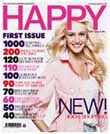 |
Happy [closed]Northern & Shell, monthly, May 2005 – March 2007 |
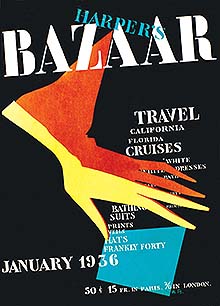 A copy of Harper's Bazaar from January 1936. It was priced in dollars, French francs and shillings |
Harper’s Bazaar (UK)National Magazines/Hearst UK, monthly, 1929-1970; 2006-Harper’s Bazaar dates back to 1867 in US. It was bought by Hearst (owner of NatMags) in 1912. It launched in the UK in 1929. In 1970, took over Queen and became Harper’s and Queen until 2006, when it reverted to the old name, by which it was known everywhere else in the world. According to the NatMags website, the company 'took over Queen for free, in return for a commitment to give the printing contract for the newly merged title to owner Michael Lewis... Circulation was boosted, and advertising soared. It has been generally judged to be the only truly successful "marriage" of two titles in the women's market.' Glenda Bailey was US editor-in-chief from May 2001 until 2020.
Before that, she edited the US edition of Marie Claire (since
1996). Bailey made her name launching the UK edition of Marie
Claire at IPC in 1988. Her first editorship was Honey in
1986. |
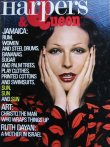 Harper's & Queen, April 1971. Helmut Newton photo of an uncredited model wearing Biba make-up |
Harpers & QueenNational Magazines, monthly, 1970 – 2006Title created when Harper’s Bazaar took over Queen in 1970. Reverted to old name in 2006. |
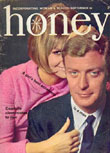 Honey from 1964. The main cover line read: 'A girl's best accessory is a man' 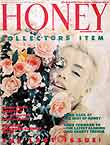 Honey final issue, September 1986 under editor Glenda Bailey: note the large 'collectors item' cover line |
Honey [closed]Fleetway/IPC, monthly, Apr 1960 – September 1986
Tag line introduced in Oct 1960: 'For the teens and twenties.' By 1962 this had become: 'Young, gay and get-ahead.' The term 'gay', then meant uninhibited and did not take on the US meaning of homosexual until the 1970s. Honey has been credited with encouraging young journalists, photographers and designers. The first issue ran photographs by George Koenig, Terence Donovan, Desmond Russell, Nigel Redhead, Julie Hamilton, Michael Ward, Basil Davis and Michael Williams. Cover credits were only given from issue 3, but Redhead, Jean Chevalier, Leo Aarons, David Bailey and Shiavone are acknowledged in the first year. The November issue (8) has a double-page spread headed 'We'd like you to meet a few of the talented people who helped us with this issue.' These included: photographers Don McCullin, Euan Duff, Victor Singh, David Bailey, Nigel Redhead and Eric Wilkins; illustrators Sirriol Clarry, Bill Banks and Michael Heath; and writer Barbara Gaskell. The magazine took over Woman & Beauty in 1964 and at its height sold 250,000 copies a month. Sales slid in the 1980s with the Jan-Jun 1980 figure of 214,349 falling to 158,438 for the same period in 1982, a drop of a quarter. In May 1986, IPC announced Honey's closure and
it was merged into 19. September was the cover date
on the last issue, which featured an article on the best of Honey and
promoted it as a 'collectors item'. The Times quoted
publisher Heather Love as saying that the reason for the
closure was the lack of co-operation from the staff with new
editor, Glenda Bailey. She had been appointed in January to
give the magazine a new direction. Bailey later went on to
launch Marie Claire. |
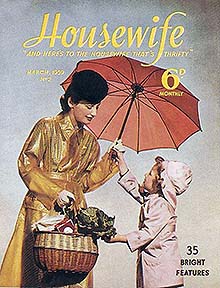 Second issue of Housewife magazine in March 1939 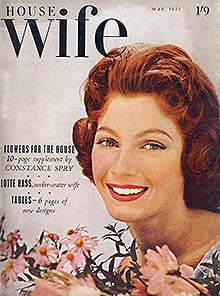 Housewife cover of May 1955, promoting a Constance Spry feature 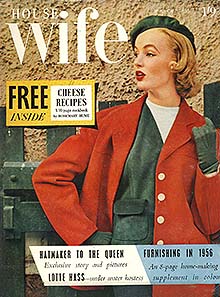 Housewife cover of March 1956 featuring a 16-page Rosemary Hume cookbook of cheese recipes |
HousewifeHulton/Longacre Press, monthly, 1939-67Housewife was launched by Hulton, publishers of the phenomenally successful Lilliput and Picture Post, just before the Second World War. It was a competitor to Good Housekeeping, which it overtook in sales in the 1950s. It launched the careers of many household names, including Constance Spry (flower-arranging), Rosemary Hume (founder of the Le Cordon Bleu London cookery school), and Phyllis Digby Morton (beauty and fashion). TV chef Mary Berry took a qualification at Le Cordon Bleu and became food editor of Housewife in 1966 (and food editor of Ideal Home in 1970-73). The editor in the late 1950s was Laurie Purden, who would go on to edit Good Housekeeping from 1967 – the year Housewife closed. |
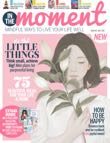 Launch issue cover of In the Moment magazine (July 2017) |
In the MomentImmediate Media, £5.99, monthly, June 2017 (July cover date) The focus was on 'positive' features and stories with a 'light-hearted approach' to inspire readers. The magazine's USP – unique selling point – was Take a Moment, an eight-page, handbag-sized mini-magazine, with a 'soothing' drink recipe, short story and puzzle. The first issue included a choice of ready-to-frame prints and card templates for pocket-sized 'greeting boxes'. Cath Potter, Immediate's publishing director, said interest in mindfulness had 'grown enormously' in the past five years with people 'crying out for ways to slow down and tune out. In the Moment recognises that being more mindful doesn’t need to be heavy-going, and that it needs to fit within your lifestyle.'
As part of the launch, promotional pages were run by the publisher's other magazines, such as Simply Crochet and Mollie Makes, alogside its Youtube page Such cross-promotion has been a vital technique for publishers going right back to the Victorian era.
|
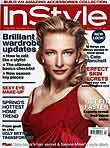 Cate Blanchett on the cover of InStyle (April 2007) |
In Style (UK)IPC Media, monthly, March 2001-2016 In October 2016, Time Inc UK announced the closure of InStyle magazine with the December issue and its 'relaunch'
as a 'digital first' product. Its headline circulation figure was 123,076 copies, but only 33,000 of those were sold at the full £3.99 cover price and 35,000 were sent out free -
a classic example of how ABC circulation figures can be deceptive. |
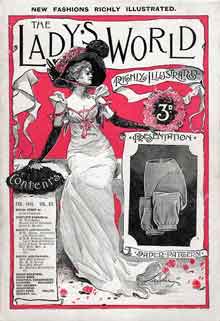 Cover of Lady's World in February 1910. The magazine ran this cover design from at least 1902 to 1921 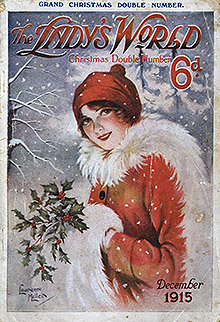 Cover of Lady's World magazine with a double issue for Christmas 1915, hence the 6d price. The cover was by Laurence Miller |
Lady's WorldMacdonald and Martin, 6 Essex St, The Strand. Monthly, Dec 1898-Sept 1926The format was similar to the Strand with more than 100 pages of editorial an issue, plus advertising. The printer was W Speaight & Sons, in nearby Fetter Lane on the other side of Fleet Street from Essex Street. Advertising for The Lady’s World in the Harmsworth magazine in 1899 put the sales at 150,000 copies a month. The cover price was 3d in 1915, but had doubled to 6d by 1920. Macdonald and Martin also published Our Home, 'the best penny paper in the world'. |
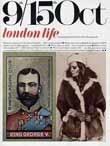 London Life – first issue under editor Mark Boxer 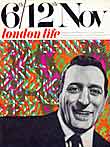 Ian Dury drew this London Life cover image of Tony Bennett for a profile by Benny Green. The words picked out in stripes against a flowery wallpaper background read: Tony Bennett / Royal / Variety / Mon 8 Nov / Palladium / 8 PM 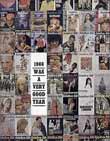 London Life with the cover line '1966 was a very good year' – but possibly not for the magazine with a change of editor |
London Life [closed]9 October 1965-1967. Illustrated Newspapers. Weekly entertainment guideThis weekly entertainment guide is included here because it incorporated the Tatler title and so linked the 1960s version of the women's monthly until it was revived a couple of years later. The editor was Mark Boxer, who had spent three years launching and establishing the Sunday Times Magazine; before that he was art director of Queen, and later became editor of a rejuvenated Tatler in 1983 (the British Society of Magazine Editors has a special achievement award named after Boxer). London Life aimed to banish the crusty old society world of Tatler and herald the new Swinging London. It typically ran to 56 or 60 pages for 2/6, with heavier coated pages used for the feature articles in a central section. It was published every Thursday (covering the Sat-Fri dates on the cover) from Elm House, 10-16 Elm St, London WC1. Its stated aim was as a 'comprehensive guide to the entertainment scene: films, theatre, restaurants, night life, music, sport' The magazine was initially printed by Sun Printers in Watford, and East Midland Litho, Peterborough and bound by Sun Printers, Watford and London. By June 1966, the printing had moved to Gale & Polden, which had its London office at 28 Craven St, a road just off The Strand with strong literary connections – Moby Dick author Herman Melville and Benjamin Franklin, the printer and publisher who became one of the American Founding Fathers, both lived there. In that year, Boxer left. The 10 September issue has a list of credits: Ian Howard was editor; picture executive was Jeremy Banks; the art editor was Tony Page; Patrick Brangwyn was production editor. For the 6-12 Nov (1965) London Life on the left, Ian Dury drew a cover image of Tony Bennett for a profile by Benny Green. Words in the background are picked out in stripes against a wallpaper background. The concept was carried through to a double-page spread showing the performers at the Royal Variety Performance that year. The colour centre spread was devoted to a 'pin-up': in this case, 'Barbara Windsor, in a dress of Plantagenet splendour, designed by Oliver Messel, for Lionel Bart's Twang!! The musical is based, freely and with baroque improvisations, on the Robin Hood legend.' The photograph was by Terence Donovan. There was a men's weekly called London Life, which was published for about 50 years until 1960. It was printed at 31 Craven Street. The Tatler London Life printer was Gale & Polden, at No 28, almost next door.Tatler London Life 1965-1966 (Tatler) magazine cover checklist |
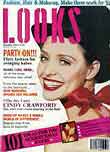 Looks at the peak of its sales in December 1992 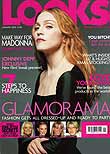 Looks with Madonna on the cover for its January 2000 issue |
Looks / Celebrity Looks [closed]Emap/Emap Elan, September 1985- February 2002Emap spent £500,000 on the launch of this fashion, beauty and haircare monthly aimed at young women aged 16-24. The launch included £400,000 spent on TV advertising and 400,000 copies of a preview issue were given away with the 18 September issue of Just 17. The first issue cost 70p for 96 pages with a print run of 200,000 – an industry rule of thumb would suggest the company was aiming for a settle-down circulation of 140,000. Ramune Burns was the editor under editorial director David Hepworth. It was an immediate success with a first ABC figure of 137,017. Burns left in July 1988 and took up a launch editor post at contract publisher Redwood on BBC Holidays 89. Morag Prunty took over the editor's chair. Table 1 lists the main teen magazines in 1988.
In 1989, Mandi Norwood was appointed editor of Looks. (By January 1991 she was in the editor's chair at Company, taking over from Gill Hudson.) By 1992, Looks was selling 231,083 but this was the peak of its sales. In December 1997, Emap Elan repositioned the title in an attempt to boost sales, which had fallen to 151,000. Eleni Kyriacou became editor. The magazine was redesigned with more emphasis on celebrities and reader make-overs. Publishing director Delyth Smith said the approach was driven by changes in the teenage magazine market, with the success of ‘baby glossies’, such as Emap's own It's Bliss and Futura's Sugar. In December, BBC Magazines announced the closure of its TV spin-off style magazine, Clothes Show. Earlier in the year, Emap had relaunched Just Seventeen as J17, taking it from weekly to monthly. In May 2001, Looks changed its name to Celebrity Looks, though editor Margi Conklin said the change just reflected what had been the case since 1998. However, in February 2002, Celebrity Looks closed. |
||||||||||||||||||||||||||||||||||||||||||||||||||||||||||||||||||
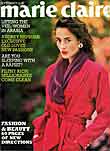 Marie Claire – launch editor Glenda Bailey had overseen the closure of both Honey and Folio when she got the job launching the title 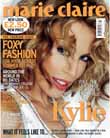 Marie Claire – softer look in March 2005 with Kylie Minogue |
Marie Claire (UK)IPC Media/Marie Claire Album, monthly, September 1988 - A measure of social change in Britain was a cross-dressing article in the first issue that focused on the male royals. Just a Paris fashion makeover of the Queen got Nova into hot water in 1968. According to the book Nova 1965-75, 'The pictures were retouched in New York and promptly impounded in Britain on their return. They were finally released only with further retouching to lower the hemline and the sanction of Buckingham Palace.' Available in cut-down A4 and 'travel-size' (in London commuter area) since September 2004, when it also cut its cover price from £3 to £2.50. Made a big fuss of running Brad Pitt on the cover and before him David Beckham. Original version founded in France in 1937 by industrialist Jean
Prouvost. One of France's leading up-market women's magazines.
First international edition was Japan in 1982. US edition began
as a bi-monthly in March/April 1995 and went monthly in September 1995. |
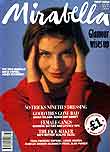 Mirabella - disappointing launch from Murdoch Magazines |
Mirabella (UK) [closed]Murdoch Magazines/News International, monthly, September 1990-
May 1991 News International closed Mirabella
in May 1991. It then sold Murdoch Magazines (Car, Supercar
Classic, New Woman, Sky and TV Guide) to Emap. No
official circulations figure had been recorded, but Mirabella was
reported as not selling well and as a new title requiring investment
would have been difficult to offload at the time when the country
was in recession. The title was originally launched by Murdoch
in the US in 1989. Grace Mirabella, a former editor-in-chief of
US Vogue was identified as the magazine's namesake and was the title’s
communications director. |
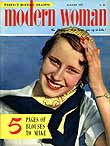 Modern Woman in August 1953 – 'The magazine that keeps you up-to-date' 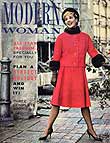 Modern Woman cost 1/9 for 92 pages in February 1962 and was stapled. Sylvia Syms modelled for the cover, which was shot by John Adriaan on what looks like a film set |
Modern Woman [closed]George Newnes (later part of IPC), 1925- (1960s?)Printed by Sun Printers in Watford. Modern Woman was based around fiction, fashion and lifestyle features. Its sales peaked in the mid 1950s at about 230,000 copies. In 1962, Modern Woman was published on the 5th of each month. In the February issue, all three short stories were bought from the US:
Among the articles was a profile of Nancy Mitford article, discussing her book on etiquette, Noblesse Oblige. It quotes her as saying that the idea for U and non-U came out of a throwaway mention in an article for Encounter (the anti-communist, Anglo-US monthly that later turned out to have been funded by the CIA). Other features were horoscopes by Leon Petulengro and a list of advertisers. Only 16 of the pages were in colour. |
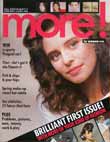 More! - launch issue 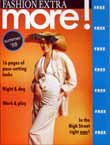 More! – 16-page fashion extra with the first issue. Centre spread was a double gatefold |
More!Emap London Lifestyle, fortnightly, 6 April 1988 -Women's lifestyle/fashion title for 16- to 24-years-olds. Most readers are single and at university or working and living at home. Sales stood at 277,000 at the end of 2005 and 271,629 at end of 2006 (though the title had gone monthly by then). In July 2007 it was announced that the title was to go weekly from September. Emap profile |


